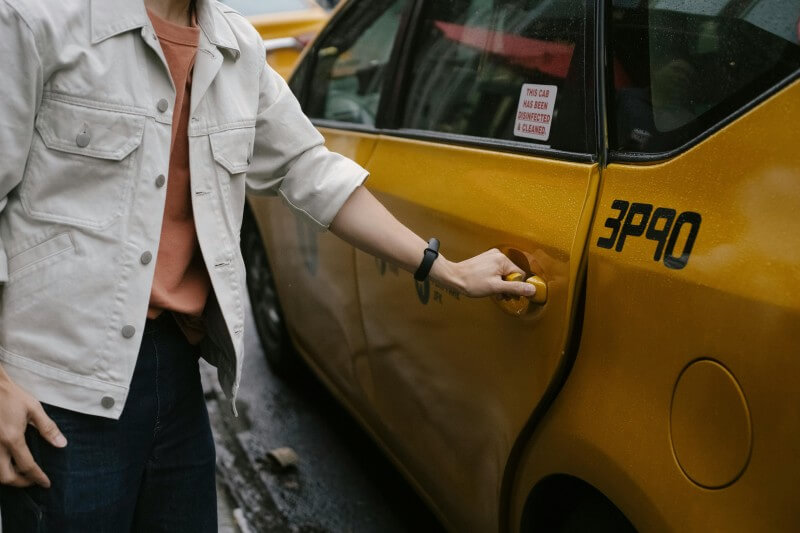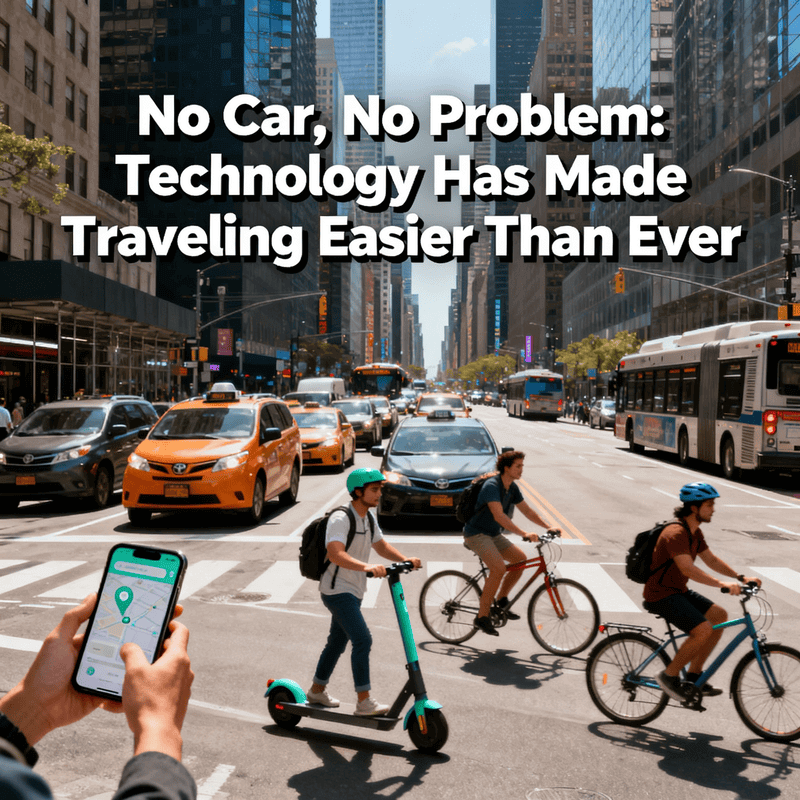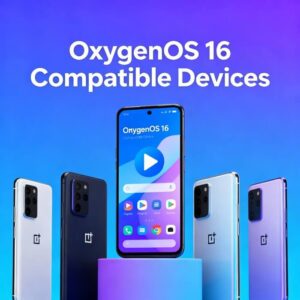Many people believe owning a car is essential for independence and convenience. However, rapid advancements in technology have changed that idea completely. From ride-hailing apps to digital navigation, travel today is smarter, faster, and far more accessible than before. These changes have opened up new opportunities for those who choose not to own a vehicle.
Not everyone in the country owns a car, yet mobility is no longer a challenge. A recent report by the Pew Research Center revealed that around 8% of Americans do not have a vehicle. Despite this, people are finding efficient ways to travel through technology-driven platforms that make commuting simpler and more affordable.
From smart public transit to shared mobility services, modern travel tools bring comfort and choice to everyone. In this article, we will discuss how technology has made travelling easier for non-car owners while maintaining convenience.

How Ride-Hailing Apps Deliver Door-To-Door Convenience
Ride-hailing apps make travel simple and stress-free. With just a few taps, a car arrives at your doorstep. For people without a vehicle, this offers flexibility and freedom to move anytime. Cashless payments and driver ratings further add to the comfort and reliability of each trip.
The growing use of technology has made these apps smarter and more efficient than ever. Features like GPS tracking, route optimization, and AI-based driver matching ensure faster pickups and smoother rides. The trend is evident, as the North American ride-hailing market is projected to reach $92.23 billion by 2030, as per TechSci Research.
However, the growing popularity of these apps has also raised safety concerns. In companies like Uber, reports of passenger harassment and misconduct have become a serious issue. According to TruLaw, Uber’s safety reports revealed 3,824 cases of sexual assault and misconduct between 2019 and 2020.
Victims of such incidents often experience lasting trauma and emotional distress. Many are seeking justice through an Uber sexual assault lawsuit, which helps them pursue compensation and accountability. These legal steps push companies to strengthen safety for users.
Passengers can use safety tools built into these apps to protect themselves. Options like live trip sharing and emergency alerts allow quick action if something feels unsafe.
Read More: Audi Concept C: Audi’s Bold Leap into the Electric Sports Car Era
Smart Public Transit With Apps and Real-Time Data
Technology has revolutionized public transport by putting real-time information at commuters’ fingertips. Apps now use GPS and data analytics to show live schedules, delays, and crowd levels. This allows passengers to plan efficiently, avoid waiting, and make better travel decisions based on accurate, up-to-date data.
According to the American Public Transportation Association (APTA), commuters took 7.7 billion trips on public transit in 2024. That’s a 7% increase from 2023, reaching 85% of pre-pandemic levels. This rebound is fueled by technology, with tools like automated tracking and digital payments making transit smoother and more reliable.
Integration technology has further expanded convenience. Smart mobility apps connect buses, trains, bikes, and scooters into a single digital platform. With AI-based route optimization, users can plan multimodal trips quickly and switch between transport options with ease.
Machine learning and IoT are now powering the next phase of smart commuting. Sensors track vehicle locations and occupancy, while predictive algorithms forecast delays and demand. These innovations are transforming urban travel into a faster, safer, and more connected experience for riders everywhere.
Read More: Machine Learning in Edge Computing: Smarter Devices, Less Cloud Dependency
Micromobility Solutions: Scooters, Bikes, E-Scooters

Technology has changed the way people travel short distances. Shared bikes, e-scooters, and mopeds now make last-mile travel faster and more convenient. With easy app access and nearby docking stations, users can unlock a ride within seconds. These tech-enabled systems give people more independence without the need for car ownership.
The steady growth of these options shows how important connected mobility has become. According to the North American Bikeshare and Scootershare Association (NABSA), shared micromobility trips rose 31% in 2024 to 225 million across North America. Around 415 cities now offer such systems, and 74% of riders use them to connect with public transit.
Wondering how technology actually makes these rides so convenient? Here are a few ways it’s transforming everyday travel:
- App-based access: Riders can unlock, reserve, and pay for rides directly through an app, reducing wait times and hassle.
- GPS tracking: Real-time location data helps users find nearby scooters or bikes quickly and plan efficient routes.
- Geofencing technology: Digital boundaries prevent unsafe riding areas and help manage parking more effectively.
- Smart safety features: Built-in sensors, lights, and automatic speed control enhance user safety during rides.
- Battery and maintenance tracking: Apps monitor vehicle health, ensuring users get reliable, well-maintained rides every time.
Read More: Modern Car Key Security: Technologies and Tips to Protect Your Vehicle
Community Shuttles and App-Based Ride Networks
Technology is redefining how small communities move. App-based shuttles and shared ride networks now fill the gap between public transit and private cars, offering flexible routes that adjust to passenger demand. These systems make short-distance travel smoother and more inclusive.
Behind the scenes, algorithms analyze rider requests in real time to map the most efficient routes. This dynamic scheduling reduces empty seats, cuts wait times, and lowers emissions, creating a more sustainable transport model.
Integrated payment platforms have also simplified the user experience. Passengers can plan, book, and pay for rides within one app, avoiding cash transactions and ticket confusion. These seamless features make commuting simpler for everyone, including seniors and first-time users.
Smart tracking tools give users peace of mind. They can monitor driver locations, estimated arrival times, and even vehicle occupancy, making local travel safer and more predictable than ever before. This transparency builds trust and encourages more people to choose shared travel options.
FAQs
1. Are subscription-based transport passes becoming popular for non-car users?
Yes. Many urban areas now offer app-based subscription passes combining buses, trains, micromobility, and ride-hailing credits. These all-in-one digital plans simplify budgeting, reduce separate fare payments, and offer seamless switching between modes. Technology enables users to manage, renew, and track usage directly through integrated mobility apps.
2. Does micromobility require a smartphone and data plan?
Usually yes. Most shared bikes and scooters depend on mobile apps and GPS for unlocking, payments, and tracking. However, some systems provide kiosk access or SMS-based unlocking for users without smartphones. These offline options ensure wider accessibility while maintaining efficient, technology-driven management of shared micromobility services.
3. Can demand-responsive transit replace regular bus and train services?
Not entirely. Demand-responsive systems complement fixed-route transit by serving low-density or suburban areas. They adapt routes in real time based on rider requests. Technology-driven scheduling, mapping, and booking tools enhance efficiency, but high-capacity routes like buses and trains remain essential for urban commuting and large passenger volumes.
Technology has opened multiple ways for people without cars to travel freely. Ride-hail apps offer convenience, with safety demands rising after issues like the Uber sexual assault lawsuit. Public transit apps and live data make commuting more reliable.
Micromobility bridges the gap between stops and destinations. Demand-responsive transit fills in coverage gaps. Together, they reduce dependence on car ownership. Travelling has truly become easier than ever for non-car owners.







